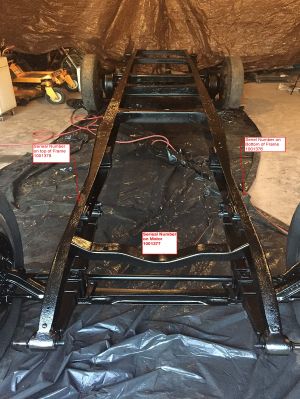- Home
- About Us
- Join/Renew
- Member Benefits
- Member Pages
- Log In
- Help
- Museum Store
I am curious as to how many Fleet Arrow Wagons were actually produced. There are around 590 serial numbers or so, 1001001 to about 1001590 if I remember correctly. While sandblasting and painting the frame I discovered a third number on my truck, see picture for details. The three numbers 1001376, 1001377, and 1001378 are in sequence. If there are 3 numbers on each vehicle one would assume there would be less then 200 Fleet Arrows that hit the streets. Any comments?

The plot thickens.
Thanks for keeping us up to date with all your trials and tribulations.
Keep ’em coming. 
Probably the most interesting project I have done. Fun Stuff!
I am not sure if you have seen the blog discussion several years ago by the American Truck Historical Association (ATHS) about Fleet Arrows mentioning 500 units, without any source citations. Your discussion about them appears to be the only update on the subject.
The Pierce-Arrow Collection at the University of Michigan’s Hatcher Library (most of what is left of the original factory records) has a giant-size newspaper scrapbook for one-half of 1928 which should have something about customers and orders; separately, there are the original factory photos of Fleet Arrow trucks. There may be other information there, sitting in a box.
A couple of years ago the Florida Region took one of the UofM Fleet Arrow photos (with the stake truck configuration) and made a Zazzle postage stamp from it. We were about to issue more this year when the Post Office suddenly lowered postal rates. Not being allowed to make good-until-used rate stamps, the Region is eagerly waiting to learn the 2017 rates.
Brooks
Brooks,
Thanks for the information I am going to continue to dig into it and will publish any solid information I come up with. I think it would be a great project for a history student at the U of M to get some extra points.
The number on the right hand frame rail is the VIN and this location is consistent with that used on the Series 80/81 passenger car. The engine serialization is independent of the VIN though Pierce elected to use the same numbering scheme. The engines are unique to the application due to having a governor.
The number on the bottom of the left hand rail is likely for matching purposes. Take a look at page 34 of the parts manual and notice each frame rail, gusset plate and cross member specified and shown with holes in place. These components were then likely assembled on a master jig and further finessing and possibly match machining was required to achieve desired alignment. Now look at the top left corner of page 1 of parts manual. The frame is specified by part number 2 ways, semi-finished and finished. The semi-finished state could be fully machined and stored as a matched kit.
Charles – I almost forgot to mention the General Profit and Loss Statements that were a part of Pierce’s reports to the Board of Directors – they include production and sales numbers compared with the prior year. Those records are now at the Studebaker National Museum in South Bend. The 12 months thru December 1929 figures show 1038 commercial and trucks made in 1928 and 999 sold; with 387 made in 1929 and 507 sold. The reports were issued monthly, so it should be possible to establish the month your truck was made with the monthly numbers. I do not have those records – they need to be obtained from the museum.
If you want to look further, sales registrations (as opposed to dealer sales on the Pierce reports) were published monthly on a state-by-state basis in Automotive Daily News. They are on microfilm at the Library of Congress and the Detroit Public Library.
Brooks
